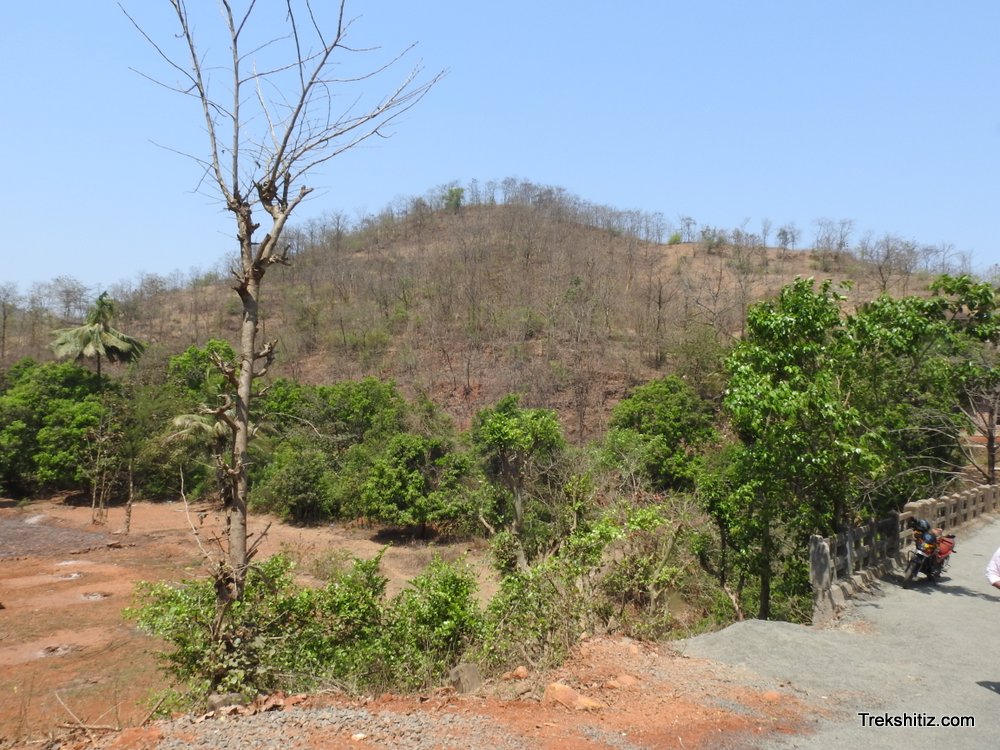The two small rivers of Dhakti and Kodjai served a trade route for the port of Dabhol. This fort was built on the mountain between the two rivers so as to protect this trade route. After visiting Panhalekaji caves the road ascends to Panhalekaji village. The point where the village ends a temple of Goddess Jholaidevi is located on a hill to the left. It takes a 15 steps ascend to reach this temple. The rocks used to build these steps have carvings on them. The original temple was built out of black rock. However it no longer exists. What we see today is the rebuilt temple structure built of cement concrete and the rocks from the old structure can be seen scattered aside. There is a stage built in front of the temple, besides which a path takes us to the cleft between the Jholaidevi hill and Panhale fort; also called as Pranalak fort. There are two paths from here of which we have to take the right path to ascend further.
The fort had dual fortification wall. By crossing the first wall we reach the water tank carved in rock within 5 minutes. Just before the tank we can see the steps carved in rock. On the upper side there are remnants of the fort wall from where we enter the fort. Due to the farming activities on the fort summit, the remnants of the fort parts lie scattered on the fort. There are many bricks on the fort which can be dated to different eras and also the limestone mixer made of stone could be found. The local villagers erected a statue of Chatrapati Shivaji Maharaj in 1994. Besides the statue there a pillar of approx. 4 feet lying on the ground. Towards the right side of the statue there is a path which descends from the fort. On this route by avoiding the Jholaidevi temple route take the opposite route to reach a dried up water tank which is supported by built in pillars. After this we have to get back to the cleft between the fort and Jholaidevi temple. From here take the route opposite to the village and start descending where we come across a path to the right side. There is a dried up water tank here. After seeing this by coming to the Jholaidevi temple we complete the fort visit. As many routes are confusing and the parts of the forts are scattered over the fort it is recommended to take the help of a local villager as a guide.
|
| Ways To Reach : |
Via Khed:-
Khed is a station on the Konkan Railway route. A bus leaves at 5.30 pm from here to Panhalekaji. Otherwise one has to get down at Vakavli junction on the Khed – Dapoli route and board the bus coming from Dapoli for Panhalekaji. Auto tickshaws are also available to reach Panhalekaji village which is at 18 kms. Vakavli is equidistant from Khed and Dapoli at 14 kms.
With our own private vehicle one can take Khed – Dapoli route and use the diversion for Panhalekaji. The road from here is in a very bad condition so it takes very long time even for a 18 kms drive. Panhalekaji caves are to the right after crossing the Kodjai river bridge. The same road further continues to Panhalekaji village and Jholaidevi temple.
Vi Dapoli:-
On the Dapoli – Dabhol road, one can go via Dapoli – Terevayangani – Gavhane – Panhalekaji village. Here we come to Jholaidevi temple first and then further to the caves.
|
| Accommodation Facility : |
| Available at Khed and Dapoli |
| Food Facility : |
| Available at Khed and Dapoli |
| Drinking Water Facility : |
| Not available |
| Time To Reach : |
| 10 minutes from Jholaidevi temple |
| Best Season To Visit : |
| Except monsoon season |
